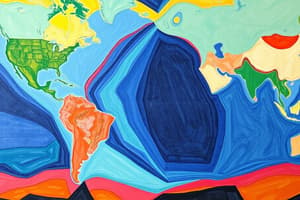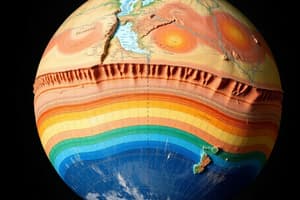Podcast
Questions and Answers
What is the primary driving force behind plate tectonics?
What is the primary driving force behind plate tectonics?
- Atmospheric pressure
- Erosion by wind and water
- Tidal forces from the moon
- Convection currents in the Earth's mantle (correct)
Subduction zones are regions where two tectonic plates are sliding past each other horizontally.
Subduction zones are regions where two tectonic plates are sliding past each other horizontally.
False (B)
Name the three main types of plate boundaries.
Name the three main types of plate boundaries.
convergent, divergent, transform
The process by which new oceanic crust is formed at mid-ocean ridges is called ______.
The process by which new oceanic crust is formed at mid-ocean ridges is called ______.
Match the following plate boundary types with their associated geological features:
Match the following plate boundary types with their associated geological features:
Which of the following geological features is commonly associated with a divergent plate boundary?
Which of the following geological features is commonly associated with a divergent plate boundary?
The Earth's lithosphere is composed of the crust and the uppermost part of the mantle.
The Earth's lithosphere is composed of the crust and the uppermost part of the mantle.
What type of plate boundary is responsible for the formation of the Himalayan mountain range?
What type of plate boundary is responsible for the formation of the Himalayan mountain range?
The San Andreas Fault in California is an example of a ______ plate boundary.
The San Andreas Fault in California is an example of a ______ plate boundary.
Match the following terms with their definitions related to plate tectonics:
Match the following terms with their definitions related to plate tectonics:
What is the name given to the supercontinent that existed approximately 300 million years ago?
What is the name given to the supercontinent that existed approximately 300 million years ago?
Oceanic crust is generally thicker and less dense than continental crust.
Oceanic crust is generally thicker and less dense than continental crust.
What is a hotspot, and how does it relate to plate tectonics?
What is a hotspot, and how does it relate to plate tectonics?
The angle at which a subducting plate descends into the mantle is called the angle of ______.
The angle at which a subducting plate descends into the mantle is called the angle of ______.
Match the following concepts with their descriptions:
Match the following concepts with their descriptions:
Which of the following is NOT a consequence of plate tectonics?
Which of the following is NOT a consequence of plate tectonics?
Volcanoes are only found at plate boundaries.
Volcanoes are only found at plate boundaries.
Explain the difference between the terms 'continental drift' and 'plate tectonics'.
Explain the difference between the terms 'continental drift' and 'plate tectonics'.
The magnetic field recorded in oceanic crust provides evidence for ______.
The magnetic field recorded in oceanic crust provides evidence for ______.
Match the following plate tectonic settings with their resulting hazards:
Match the following plate tectonic settings with their resulting hazards:
Flashcards are hidden until you start studying




